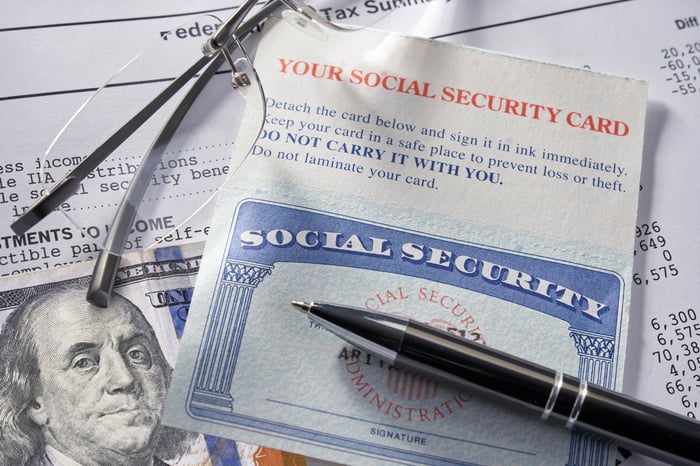3 Little-Known Factors That Could Affect Your Social Security Benefits
A growing number of Americans are heavily reliant on Social Security to make ends meet in retirement. 60% of retirees said Social Security represents a major source of income for them, according to the most recent edition of an annual Gallup poll. While that number fluctuates, it's the second-highest reading in the poll since it started in 2002.
But many Americans are unfortunately unaware of how different factors could affect that all-important source of retirement income. A lot of things go into calculating how much you'll receive each month, but these three factors can easily go overlooked.
Where to invest $1,000 right now? Our analyst team just revealed what they believe are the 10 best stocks to buy right now. See the 10 stocks »

Image source: Getty Images.
1. Working while collecting benefits
If you continue to work while collecting Social Security, there are two potential effects on your retirement benefits.
First, you may be subject to the Social Security earnings test. If you earn income while collecting Social Security before reaching your full retirement age, the Social Security Administration, or SSA, will reduce your benefits if you earn over a certain threshold.
For every $2 you earn over the threshold, the SSA reduces your annual benefits by $1. During the year you reach full retirement age, the threshold increases while the reduction is only $1 for every $3 earned over that amount. For 2025, the earnings test threshold is $23,400 (or $62,160 if you reach full retirement age this year).
Those benefits aren't lost for good, though. The SSA will adjust your benefit once you reach full retirement age. For each month's worth of benefits deducted due to the earnings test, the SSA will adjust your benefit as if you delayed your initial application by one month. Ultimately, this results in a higher benefits check once you do reach full retirement age.
The second effect working while collecting benefits can have is that it could increase your monthly check. When the SSA calculates your benefit, it takes the 35 highest-earning years from your career after adjusting for inflation. If you've worked less than 35 years or earn enough to replace one of your 35 highest-earning years, you'll see a boost to your benefit once the SSA recalculates it at the start of the year. You can view your adjusted earnings history online with a My Social Security account.
2. Remarrying
If you're divorced or a widow(er), you might want to check how your Social Security benefits could be affected before remarrying.
Divorced spouses are eligible for spousal benefits based on their ex-partner's earnings record as long as they were married at least 10 years. Spousal benefits can be worth up to half of your ex-partner's primary insurance amount, or the amount they qualify for when they reach full retirement age. You can claim those spousal benefits even if your former partner hasn't claimed their own, ensuring you don't have to collaborate with them to decide when to start benefits.
However, if you remarry, you'll no longer be eligible for those spousal benefits. You'll be eligible to collect based on your new spouse's earnings record but only once they start collecting benefits first.
Widow(er)s are eligible for survivor benefits as long as they were married at least nine months prior to their spouse's passing. Ex-spouses are also eligible if they were married at least 10 years. Survivor benefits entitle you to a benefit worth as much as the deceased's primary insurance amount if they hadn't started collecting prior to their passing. If they were already receiving benefits, you could collect as much as they were previously receiving.
You'll no longer be eligible for survivor benefits if you remarry before reaching age 60. If you get married after your 60th birthday, though, you can still apply for survivor benefits based on your former spouse's earnings record.
3. Medicare premiums
Seniors become eligible for Medicare starting at age 65. If you opt into Medicare for your health insurance while collecting Social Security benefits, the SSA will automatically deduct your Part B premiums from your monthly checks.
But Medicare and Social Security don't adjust their numbers on the same schedule. For example, the 2025 Social Security COLA was 2.5%. The average retirement beneficiary saw their total monthly benefit increase about $48 based on December data. However, anyone on Medicare saw their Part B premium increase at least $10.30 per month to $185. That's a 5.9% increase.
As such, it might seem like you're not getting the full COLA. You are -- it's just that your healthcare costs increased faster. The rising cost of healthcare can be a serious drag on seniors' budgets, so it's worth paying attention to how your Medicare premiums will affect your Social Security benefits along with all the other factors discussed above.
The $22,924 Social Security bonus most retirees completely overlook
If you're like most Americans, you're a few years (or more) behind on your retirement savings. But a handful of little-known "Social Security secrets" could help ensure a boost in your retirement income. For example: one easy trick could pay you as much as $22,924 more... each year! Once you learn how to maximize your Social Security benefits, we think you could retire confidently with the peace of mind we're all after. Simply click here to discover how to learn more about these strategies.
View the "Social Security secrets" »
The Motley Fool has a disclosure policy.
